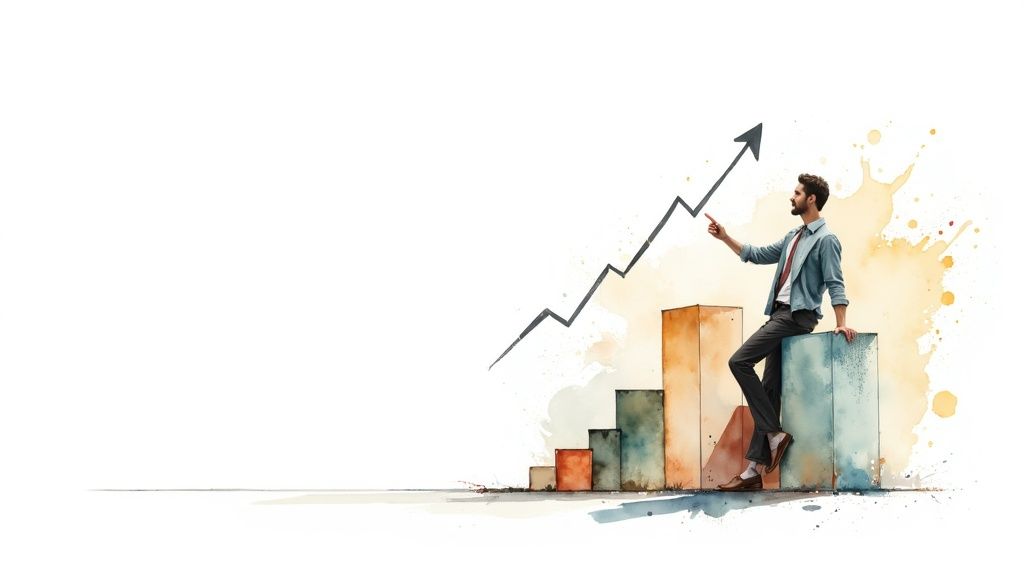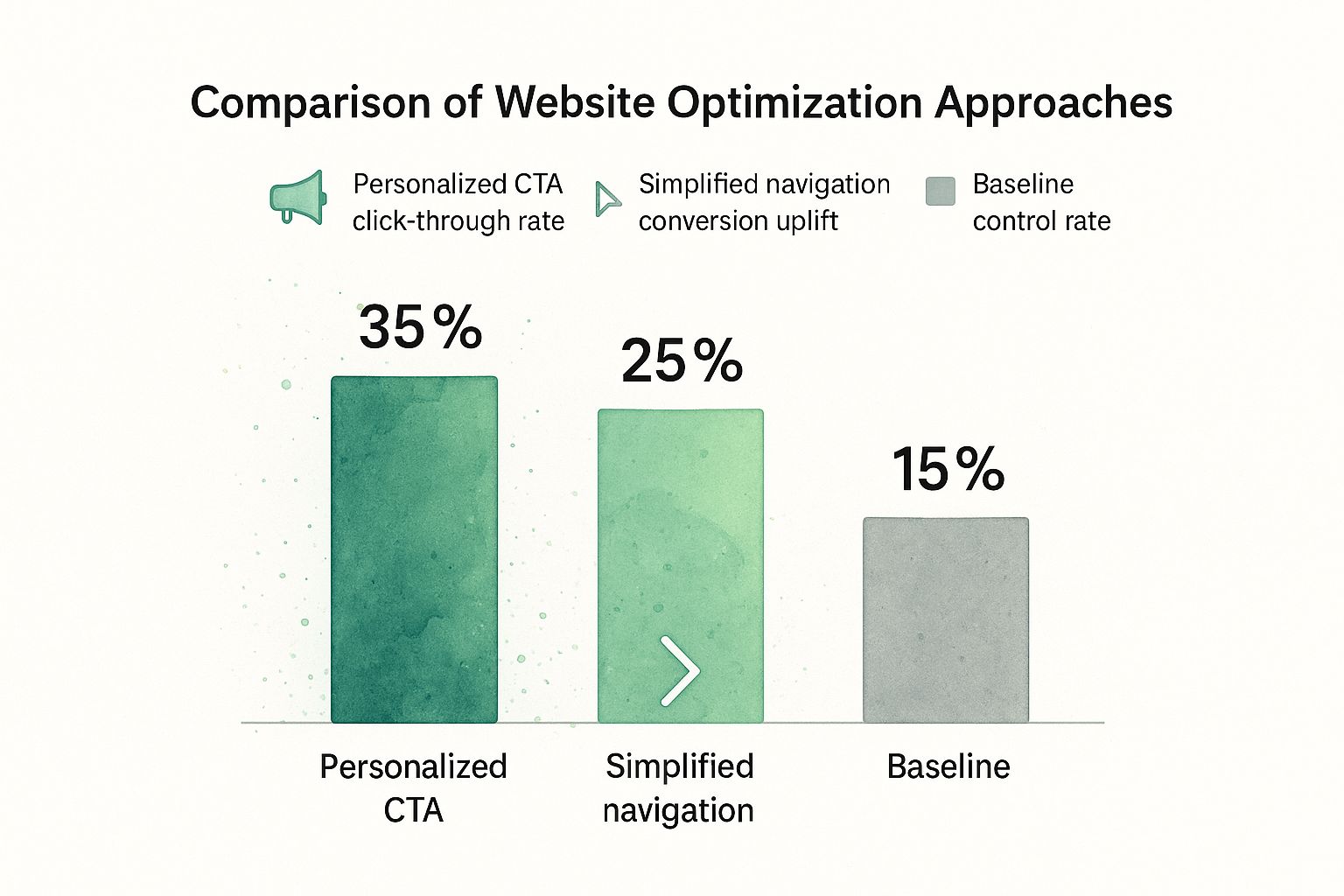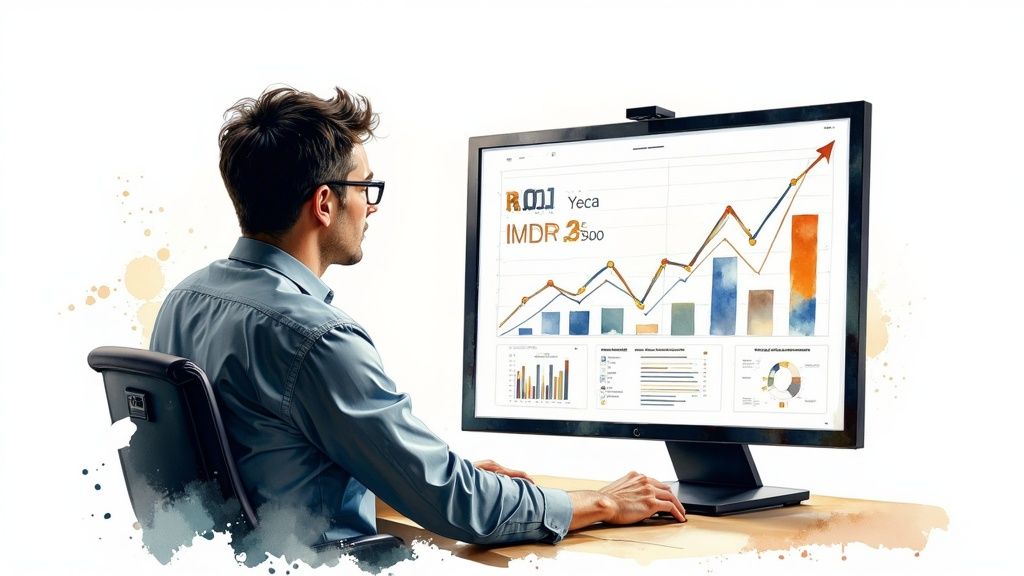You invest in SEO and ads, but those visitors just aren't becoming customers. You're not alone. This is precisely where website conversion optimization (CRO) makes the difference.
Think of your website as your most important salesperson. In this article, you'll learn how to train this salesperson to deliver top performance. We'll cover how to truly understand your customers, analyze your website like a pro, and use A/B testing to make decisions based on data, not gut feelings.
What Conversion Optimization Really Means for Your Business

Many entrepreneurs struggle with low conversion rates. They attract visitors, but they drop off before making a purchase or contacting them. Conversion optimization, often abbreviated as CRO, is the process of improving your website so that more visitors do what you want them to do. Instead of constantly chasing new traffic, you simply get more value from the visitors you already have.
With a smart CRO strategy, you ensure your website doesn't cause confusion and frustration but smoothly guides visitors toward a purchase. This turns your website into an efficient growth engine for your business.
More Than Just a Higher Conversion Rate
Of course, the ultimate goal of CRO is to boost your conversion rate, but the benefits go much further. A well-optimized website elevates the entire user experience (UX) to a higher level. Visitors find what they're looking for faster, build trust in your brand, and are more likely to return.
A strong CRO strategy helps you to:
- Maximize the ROI of your marketing: Every visitor you bring in through paid ads or SEO has a greater chance of converting. Your marketing budget, therefore, yields more direct returns.
- Gather valuable customer insights: By analyzing behavior and conducting A/B tests, you discover what drives your target audience, what their objections are, and how they make decisions.
- Build a sustainable competitive advantage: While your competitors keep pumping money into more traffic, you build a more efficient machine that gets more out of the traffic that's already there.
Before we delve deeper into the methods, it's good to have a clear understanding of the basic principles of conversion optimization. Together, these elements form the foundation of every successful CRO strategy.
The Core Pillars of Conversion Optimization
| Pillar | Description | Example |
| Data-Driven Analysis | The systematic collection and analysis of data to understand how users behave on your site. | Using heatmaps to see where visitors click and scroll on a product page. |
| User Experience (UX) | Designing an intuitive, frictionless, and pleasant experience for the user. | Simplifying a checkout process by removing unnecessary fields. |
| Hypothesis & Testing | Formulating a testable hypothesis and validating it with A/B or multivariate testing. | Testing whether a green CTA button converts better than a blue one. |
| Persuasive Copywriting | Writing convincing and clear texts that prompt the visitor to take action. | Rewriting a product description to focus on benefits instead of features. |
| Continuous Improvement | Realizing that CRO is an ongoing process of learning, adapting, and optimizing. | Using the results of one test as input for the next hypothesis. |
These pillars show that CRO is much more than changing a few buttons; it's a strategic approach that touches the very core of your online business.
A Continuous Process of Improvement
It's crucial to understand that conversion optimization isn't a one-time project. It's an ongoing cycle: analyze, form a hypothesis, test, and learn. The market and consumer behavior are constantly changing, so your website must evolve with them.
Notably, the adoption of CRO technologies in the Netherlands is still relatively modest, which presents a huge opportunity for companies that lead the way. In 2025, only about 2.1% of Dutch websites use specific tools for conversion optimization. Within this niche, Elfsight is the market leader with a 24.3% share. This shows that companies investing in CRO now can gain a significant lead. Discover more insights about the use of conversion optimization in the Netherlands.
At Digitalique.nl, we see CRO as the bridge between what your company offers and what your customer truly needs. It's not about tricks, but about creating a seamless and convincing online experience that stimulates sustainable growth.
Understand Your Customer for Higher Conversions
Before you even think about changing a button color, the absolute first step in website conversion optimization is to truly understand your visitors. Making changes based on a gut feeling is like driving with a blindfold on; you probably won't get where you want to go. Real, effective optimization starts with data.
Get inside your visitor's head. What are they really trying to achieve on your site? What questions do they have? And, crucially, what's stopping them from taking that final step? Answering these questions is what separates a strategic plan from random guesswork.
Digging into Quantitative Data
Let's first look at the information you already have. Quantitative data tells you what is happening on your website. Tools like Google Analytics are brilliant for spotting behavioral patterns.
Here, you're looking for red flags and hidden opportunities. Are people abandoning your site in droves from one specific page? Is your mobile conversion rate much lower than your desktop rate? These numbers don't tell you why it's happening, but they point you directly to the problem areas.
This screenshot from Google Analytics shows a typical dashboard for tracking user acquisition and engagement.
By diving into these reports, you can easily find pages with high traffic and a shockingly high exit rate. That's a clear sign of friction in the customer journey and a perfect place to start your investigation.
Qualitative Insights for the Full Story
While the numbers show you the what, qualitative data is about the why. This is where you uncover the human stories behind the clicks. It's about feeling the frustration, understanding the motivation, and seeing your site through your visitors' eyes.
Some powerful ways to get this context are:
- Heatmaps and Session Recordings: Tools like Hotjar or Clarity are fantastic. They visually show where users click, how far they scroll, and where their mouse hovers. Session recordings are even better—it's like looking over someone's shoulder as they use your site, so you can see exactly where they get stuck or confused.
- Customer Surveys and Feedback Polls: Sometimes the simplest solution is the best: just ask. A small, polite pop-up survey on a high-exit page asking, "What stopped you from completing your purchase today?" can yield golden insights.
- User Testing: Here, you ask real people from your target audience to perform tasks on your site while thinking aloud. Their live, unfiltered feedback is invaluable for spotting usability issues you've become blind to.
Combining the 'what' from quantitative data with the 'why' from qualitative feedback is the magic formula. Data might show a 70% drop-off on the shipping page, but a survey might reveal that unexpected shipping costs are the direct cause.
Create Action-Oriented Customer Personas
The final piece of the puzzle is to bring all your research together into customer personas. We're not talking about generic personas full of demographic data that end up in a drawer. For CRO, your personas must be built for action.
Your personas should provide clear answers to questions like:
- What is their primary goal when they land on your site?
- What are their biggest frustrations or pain points with your type of product or service?
- What are their main drivers to buy?
- What specific information do they need to feel confident enough to convert?
By understanding the entire customer journey , you can tailor every part of your website to their needs. Our guide on mapping the customer journey provides a framework for visualizing every touchpoint. This complete picture is essential for a website that not only attracts traffic but consistently turns visitors into loyal customers.
How to Analyze Your Website Like a Pro

Data is the engine of effective website conversion optimization, but you can also get hopelessly lost in it. To make truly smart decisions, you need a sharp focus. It's not about endlessly clicking through reports, but about asking the right questions and knowing exactly where to find the answers.
You really don't need to become a data scientist. It's about learning to listen to the signals your website is giving you. This way, you move away from guesswork and form strong, testable ideas based on real user behavior.
Unearthing Insights from Google Analytics 4
Google Analytics 4 (GA4) is your most important tool for understanding the customer journey. However, its real power isn't in the standard dashboard, but in specific, targeted reports that show exactly where your opportunities lie. Forget superficial metrics like total visits; dive into the reports that show you the paths and stumbling blocks of your users.
Two reports you absolutely must get to know are:
- Conversion Paths: This report shows you the exact sequence of channels a visitor interacts with before a conversion occurs. You might discover that social media doesn't lead directly to sales but plays an indispensable role in the early stages of the customer journey.
- User Explorer: Here, you can analyze the anonymized behavior of individual users. You follow their entire journey, step by step, from their first visit to their last action. Perfect for spotting confusing navigation or endless click-loops.
Want to dig deeper and really make GA4 work for you? Read more about our Google Analytics diensten and discover how we turn data into action.
Data tells a story. A high exit rate on your contact form isn't just a number; it's the story of a visitor who became frustrated, confused, or uncertain at the last moment.
Putting the Conversion Funnel Under a Microscope
Analyzing your conversion funnel is like detective work at a crime scene—the crime of a missed sale or lead. You visually map out the steps a user takes, for example, from the homepage to a product page, to the shopping cart, and finally to the thank-you page.
By mapping this journey, you can immediately see in which phase the largest percentage of users "leaks" out. Does it happen when they see the shipping costs? Or is there an unclear step in the registration process? Identifying this bottleneck is half the battle.
For e-commerce sites, it's important to know where you stand. In the last quarter of 2023, the average conversion rate was around 2.8%. Knowing that direct traffic converts the highest (3.3%) and paid search traffic sits at 3.2% helps you set realistic goals. This gives you a benchmark to compare your own performance against.
Don't Forget the Technical Audit
All your customer journey analyses are for nothing if your website is technically flawed. A technical audit is a fundamental part of website conversion optimization because it has a direct impact on the user experience and, therefore, on your conversions.
A few crucial technical factors to check:
- Speed: Every second counts. A slow page is an absolute conversion killer, especially on mobile devices where users' patience is even thinner. Use tools like Google's PageSpeed Insights to see where the brakes are.
- Mobile-Friendliness: Your website must offer a flawless experience on every device. Having to zoom in to tap a button is a guarantee of a lost customer.
- Browser Compatibility: Does your site work perfectly on Chrome, Safari, Firefox, and Edge? Small bugs on one browser can, in total, take a big chunk out of your revenue.
A technical audit ensures the foundation of your website is solid. Without it, you're essentially trying to fill a leaky bucket. Combine these three approaches—in-depth GA4 analyses, a funnel analysis, and a technical audit—and you'll get a complete picture of your website performance and the best opportunities for growth.
The Art of Testing: A/B Tests and AI Personalization:
Your analysis has produced a strong hypothesis. Perhaps something like: "We believe that changing our vague 'Submit' button to a specific 'Get Your Free Quote' will increase form submissions." Now what?
It's tempting to just implement the change and hope for the best, but guesswork has no place in effective website conversion optimization. To know for sure if your idea works, you need to test it scientifically. Here, you let real user behavior settle the debate, not opinions in the office.
The gold standard for this is A/B testing. Think of it as a direct competition between two versions of your webpage. You show 50% of your visitors Version A (the original, also called the 'control') and the other 50% get Version B (your new version, the 'variant'). By tracking which version generates more conversions, you get a clear, data-driven winner.
Mastering the A/B Testing Process
A successful A/B test is more than just launching two pages. You need a disciplined process for reliable results that have a real impact.
Where do you start? Focus on elements with the greatest potential to influence user decisions. We always advise looking at:
- Headlines: Does a benefit-oriented headline attract more readers than a question-based one?
- Call-to-Action (CTA) Buttons: Test everything—the text, color, size, and even the position on the page. Small adjustments here can yield surprisingly large gains.
- Page Layouts: Can a simple, single-column layout on an important landing page outperform your current design?
- Images and Videos: Does a product video really convert better than a gallery of static images? Let the data decide.
To run these experiments, you need the right tools. Google Optimize was a popular free choice but has since been discontinued. Today, platforms like VWO and Optimizely are market leaders.
Remember this: a "failed" test is not a failure. If your new version doesn't win, you've still gained a valuable insight into what doesn't work for your audience. That knowledge is just as important for your next hypothesis.
Interpret Your Results Correctly
Once your test is complete, you need to analyze the results critically. A common mistake is to declare a winner after just a few days. You must absolutely wait until the test reaches statistical significance—usually a confidence level of 95% or higher. This is your proof that the result is due to your changes, not random chance.
The Next Step: AI and Geo-Personalization
While A/B testing is fantastic for optimizing for the "average" user, personalization goes a step further. The goal is to create a unique experience for every visitor. This is where modern technology, especially Artificial Intelligence (AI), truly shines.
Consider these scenarios:
- GEO-Targeting: A visitor from Amsterdam lands on your homepage and sees a banner highlighting your Amsterdam office or local case studies. That immediately builds a connection.
- Behavioral Personalization: AI can track a user's browsing behavior on your site. If they have repeatedly viewed your SEO services, you can dynamically change the CTA on the homepage to "Discover Our SEO Packages" on their next visit.
- Dynamic Content: An e-commerce site can use AI to show product recommendations based on what similar users have purchased.
This level of personalization was once reserved for large corporations. Now, AI-driven tools make it accessible to many more businesses. This is the future of website conversion optimization: a journey that feels like a personal consultation.
Essential Elements of a High-Converting Website
Once you've dived into the data and have a few solid hypotheses, it's time to focus on the tangible parts of your website. Effective website conversion optimization isn't just about endless testing; it's about building a solid foundation with elements that are proven to guide, persuade, and reassure visitors.
Think of your website as a physical store. Is it well-lit and easy to navigate? Are the signs clear? Is the staff helpful? Every element on your site plays a similar role.
The Psychology of High-Converting Design
Good web design is much more than just making things look pretty—it's about strategically directing your visitor's attention. A visually chaotic page creates mental friction, leading to confusion and, ultimately, site abandonment. A clean, strategic design, on the other hand, makes the path you want them to take intuitive and effortless.
Some key design principles that directly influence conversions:
- Visual Hierarchy: This is how you tell visitors what's most important without saying a word. Use size, color, and placement to make your core message and call-to-action (CTA) unmissable.
- Whitespace (Negative Space): Don't be afraid of empty space. It's a powerful tool that reduces clutter, improves readability, and draws attention to crucial content.
- Strategic Use of Color: Color triggers emotion and can steer behavior. For example, use one bright accent color only for your clickable elements (like buttons and links).
This infographic shows the impact of different optimization approaches. Look at how elements like personalized CTAs can drastically outperform a standard setup.

The data is clear: personalizing the user experience, even with something as simple as a personalized CTA, can more than double your click-through rate.
Persuasive Copy that Drives Action
Your words are your digital salesperson. Generic, feature-focused copy doesn't inspire people to act. Truly persuasive copywriting connects with your visitor's problems on a personal level and positions your solution as the only logical answer.
Your copy should always be:
- Benefit-Oriented: Instead of "Our software has a new dashboard," try "Manage all your tasks in one place and save hours every week." Always focus on the result for the customer.
- Clear and Concise: Avoid jargon. Use short sentences and simple language.
- Action-Oriented: Use strong, active verbs and tell people exactly what you want them to do.
Create Irresistible Calls-to-Action (CTAs)
Your Call-to-Action is the final gateway to conversion. A weak, generic CTA like "Submit" or "Click Here" is a conversion killer because it creates uncertainty. What happens when I click?
A powerful CTA, in contrast, is specific, convincing, and sets crystal-clear expectations.
- Instead of "Download," try "Get Your Free Marketing Guide."
- Instead of "Subscribe," try "Join 10,000+ Smart Marketers."
For complex landing pages, a perfectly optimized CTA can be the single most important factor. If you really want to perfect a key page, our landing page optimisation guide offers a focused framework to get this right.
A great CTA removes the last shred of doubt for a visitor. It clarifies the value they will receive immediately after clicking, making the decision to convert feel both easy and confident.
Minimize Friction in Forms and Checkouts
Nothing kills conversions faster than a long, complicated form. Every field you ask a visitor to fill out is an extra point of friction—an extra chance for them to give up and leave.
- Ask only for what you absolutely need. Do you really need their phone number for a newsletter signup? Probably not.
- Use smart defaults and auto-fill. Make the process as painless as possible.
- Show progress. For multi-step forms or checkouts, a simple progress bar shows users how close they are to the finish line.
Build Trust with Social Proof
People trust other people far more than they trust brands. Social proof is the powerful psychological principle that we look to the actions and experiences of others to guide our own behavior.
You can weave this into your site by showing:
- Customer Reviews and Testimonials: Authentic reviews, especially with names and photos, are incredibly persuasive.
- Trust Badges: Displaying security seals (like SSL certificates) and familiar payment logos (iDEAL, Visa, PayPal) immediately reassures visitors.
- Case Studies and Client Logos: Showing that other respected companies already trust you is a powerful endorsement.
Your Questions About Conversion Optimization Answered

Diving into website conversion optimization can feel overwhelming. We get it. Over the years, we've guided countless entrepreneurs through this process and have noticed that the same questions come up time and again.
To give you real clarity, we've gathered the most frequently asked questions we hear from clients and answered them directly. This isn't theory; these are practical, straightforward answers from our hands-on experience.
How Much Does Conversion Optimization Cost?
This is almost always the first question, and the honest answer is: it depends. The cost of a CRO project is directly linked to the scope and complexity of the work.
Think of it like building a house. A simple renovation has a different price tag than designing a custom villa. Similarly, a one-time project to adjust a single landing page costs less than an ongoing CRO program with in-depth analysis, user research, and continuous A/B testing across your entire website.
Generally, the pricing structures look like this:
- Project-Based: You pay a fixed price for a specific outcome, such as a full website audit or a series of A/B tests on your checkout process.
- Monthly Retainers: For ongoing optimization, you pay a monthly fee. This is perfect for businesses that see CRO as a continuous growth strategy, not a one-off fix.
- Performance-Based: In some cases, an agency may tie a portion of their fee to the results they deliver, such as a measurable increase in revenue or leads.
The key is to stop seeing CRO as a cost and start seeing it as an investment. A successful optimization program pays for itself many times over by simply increasing the value of your existing visitors.
How Long Does It Take to See Results?
When it comes to conversion optimization, patience is a virtue. While some "quick wins"—like fixing a broken contact form—can show results almost immediately, a proper CRO process is a long-term game.
Here is a realistic timeline you can expect:
- Data Collection & Analysis (2-4 weeks): This initial phase is all about gathering enough solid data to form strong hypotheses. You absolutely cannot rush this part.
- Running A/B Tests (2-6 weeks per test): An A/B test needs to run long enough to achieve statistical significance. This means you've collected enough data to be sure the result isn't a fluke.
- Seeing Tangible ROI (3-6 months): You'll likely see small, incremental improvements along the way, but the significant, business-critical results often only become clear after a few cycles of testing and implementation.
The goal of website conversion optimization is sustainable growth, not magical quick fixes. It's about building an ever-smarter, more effective sales machine, one data-backed improvement at a time.
What Are the First Steps I Should Take?
Feeling a bit overwhelmed by all the possibilities? No need to be. The best way to start is by focusing on the "low-hanging fruit"—the areas where you can make the biggest impact with the least effort.
Your very first step should be to identify the biggest leaks in your conversion funnel. Dive into your Google Analytics data and find the pages with the highest exit rates. Where are you losing the most potential customers?
Once you've found the problem page, install a heatmap tool like Hotjar or Microsoft Clarity. Watch a few session recordings of real users on that specific page. You'll be amazed at how quickly you can see what's causing the friction.
This simple, two-step process—find the leak, then watch what users actually do—will give you your first, most impactful hypothesis to test.
Are you ready to stop guessing and start building a website that works as hard as you do? At Digitalique.nl, we combine data-driven analysis with proven strategies to turn more of your visitors into valuable customers. Let's start the conversation and unlock your website's true potential. Schedule your free strategy session with us today.